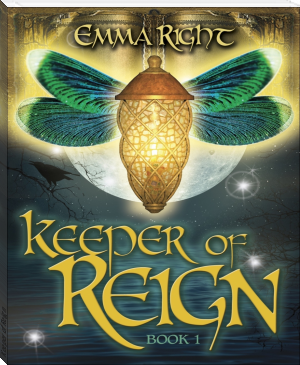The Mythomaniacs by Jules Bass (free e novels .txt) 📖

- Author: Jules Bass
Book online «The Mythomaniacs by Jules Bass (free e novels .txt) 📖». Author Jules Bass
“So, can you tell us anything, Mr. Myrddin, sir?” gabbled the heftiest of the healers.
“Sir? I’m not a ‘sir,’ I’m a kid. And I don’t remember anything,” he lied, fearing to tell what he did recall. “Nothing! Here I am. Here you are. My mind is a complete blank.”
“Our patient needs rest,” a sorcerer’s apprentice twittered.
Everyone nodded sagely, their mouths turned down and eyebrows knitted, and filed out of the room, leaving Gilbert to rest while his father kept his bedside vigil.
Henry’s thoughts took him back to the time he had started writing stories for his daughter, Marlo, when she was old enough to understand them. He never thought of them as fictional children’s stories. To Henry they were as real as if they had actually happened. Maybe that was because the essence of each of the tales was rooted in some fragment of his reality. Ideas for fairy tales and fantasy were not much different from ideas for any other kind of fiction; there was simply more latitude for invention, although both are frequently condemned as improbable. But, however far from truth the words may be, experience is usually the seed from which a fiction sprouts.
Marlo was a beautiful baby. All the doctors and nurses ooh’ed and ahh’ed over her when she was born. “A treasure,” they whispered. She never cried and always slept right through the night. “A perfect child,” everyone said to Marlo’s parents. “You’re both so lucky.”
Henry beamed with pride. Virginia cried with joy. At least at first. At least in front of others. Privately they worried that Marlo never made a sound at all. No goo-goo, gaa-gaa, whaaa-whaaa. Nothing!
“Don’t worry,” the doctors said. “In due time. All babies are different.”
Time passed, and at the age when most other babies said “mama” and “da-da” and giggled when tickled, little Marlo continued to be “different” and remained silent.
Worst of all she never smiled.
When she was two, Henry and Virginia took her to a pediatric specialist in London, where they learned the sad news: “Your daughter cannot speak or hear,” the doctor said.
“Unfortunately it appears to be a congenital problem — dating from her birth — and there’s nothing we can do. Of course, only time will tell if it is permanent.”
Again, that illusive moment: time.
Marlo went to a special school to learn sign language and lip-reading while Henry, Virginia, and young Gilbert took classes as well so that they would be able to communicate with her. She was very bright, never complained — yet she seemed strangely sad. No matter how hard Henry tried to entertain her with his magic and stories her eyes never sparkled, her lips never curled up into the smile for which his heart ached.
The family lived in Topsham, a small fishing village in Devon — four miles from the main town of Exeter, in the south-west of England. Henry owned a children’s book and toy shoppe in Exeter, on the cobble-stoned Gandy Road — a ten minute stroll from the quay of the river Exe. (All those picturesque towns always spelled words with extra p’s and e’s on the end — to add to their quaintness.) Ye Olde Book & Toy Shoppe, the sign on the window read: Henry Myrddin, Proprietor. It had been owned by three previous generations of Myrddins. There were great big stuffed chairs to snuggle in and read, a wonderful selection of new and old toys, and children’s books — including those Henry had written, and Gilbert had illustrated. They both worked at printing the books themselves. It was a paradise for kids. His workroom was a small space at the rear of the shoppe where he did most of his writing. Gilbert’s favorite time was Saturdays at eleven, when he perched on a high stool on the small stage he had built and read a story to the children. The readings were popular and Henry always had a lottery for a free book and light refreshments for everyone. He usually followed up the reading with a few magic tricks. Yes, Henry was also an amateur magician. And that’s what got him into the big trouble.
Before we get back to Henry’s story, let’s allow Marlo to grow up into a beautiful young girl of eleven. One day, on her way back from the library she saw a mime performing for a small crowd in the park at Northernhay Gardens, and she stopped to watch. The mime was a boy, a year older than she. He wore the standard costume: black tights, a striped shirt and a battered top hat. His face was white with stage make-up and his eyes looked really big because they were surrounded with black eyeliner. His lips were painted into a red bow shape. Marlo was fascinated by his act — a performance during which he told a story without ever making a sound or saying a word. She discovered the boy’s name was Paul and that he performed every Saturday and Sunday at ten, and she didn’t miss a performance that whole month. She watched intently — and learned.
Marlo decided that she needed some help in transforming herself into a mime and one day she got up the courage to confide in her mother — to tell her her secret wish to be a mime, and ask for help.
“I think that’s a wonderful idea,” her mother signed (for she was getting pretty good at communicating with her lovely daughter). Marlo’s infirmity was not something to cry over any more — it was something to have fun with, to be proud of. Like learning a new way to ‘speak:’ Sign language. Virginia found an old pair of black tights and bought Marlo a red and white striped long-sleeve shirt along with some cosmetics — and at the library she found an old picture book about pantomime and made up Marlo’s face as a classic mime. She even added some big pointy eyebrows that looked like upside-down “V’s,” with star-burst lines around the eyes, and painted a bright lipstick-red smile on Marlo’s lips. The eyes and the red smile gave her daughter a surprised look. She looked the perfect companion to her friend Paul.
“Now we have to create an act for you,” her mother signed. “You look wonderful and so happy with your new painted-on smile. I only wish it were real.”
“I’d like to use some recorded music and some dance steps,” Marlo signed.
“But how will you hear it?” Virgina signed, rather sadly.
“Aha,” Marlo giggled. “I’ve already thought all about that and have been doing some practicing. Wanna see?”
“You bet I do. I can’t wait.”
Virginia had to hold back her tears as her talented daughter put some music on a portable player she had strapped to her waist.
“Guess you’re wondering how I can hear it, huh?”
“Must say, I am… so show me, darling”
“I’ve learned to dance to the vibrations I feel from the musical sounds I feel pulsing through my body. I’ve been practicing every day after school for a month now.”
And so Marlo played the music and began to dance — perfectly in rhythm… and Virginia couldn’t help but join her.
“Let’s keep it a surprise from dad, okay?”
“He’ll love it. Just tell me when and I’ll be sure he’s there.”
Soon she was ready for her debut. She picked a spot on the historic quayside and began to mime. Without words, she “told” her own story: the story of a girl who was born not able to hear or speak and decided to become a performer. A small crowd gathered and when her turn was completed they applauded. Marlo couldn’t hear the clapping, but she saw it — and saw the happy faces — which told her that she had brought pleasure to them and, more importantly, to herself. She made three pounds that day. She had found something she could do, and do well.
Marlo’s mother pretended she hadn’t seen her performance and that next Saturday she brought her husband, Henry, and her son, Gilbert — and they all laughed and cried at seeing this wonderful little girl perform. It was heartbreakingly beautiful. They all hugged and kissed her after the show and her father asked if she would give a performance at his shoppe. She agreed — and the kids loved her. She became an important part of the Saturday’s-at-eleven show. No one expected her to speak; after all, she was a mime.
A few weeks later, when Marlo felt more confident about her abilities, she invited her friend Paul to work with her. For these performances he dressed as a Harlequin — in the traditional body-suit of multicolored diamond-shaped fabrics sewn together, a floppy hat, an eye mask and low shoes that curled up at the toes. She played Columbine, a girl mime. The Harlequin/Columbine combination had long been famous in British pantomime and at first Marlo and Paul put on the classic stories of Cinderella, Mother Goose and Jack and The Beanstalk. Later, they planned to turn some of Henry & Gilbert’s books into pantomime plays.
It was during one of their Saturday shows that the white cat showed up.
Henry began to pace around the hospital room. Aloud, he said: “If only that white cat hadn’t shown up, things would have turned out differently.”
Gilbert opened his eyes and pulled at his beard. “The white cat. I miss that little guy. I remember when I first saw him.”
Henry looked at his bearded son and wondered how all this was going to end. Surely Gilbert would suddenly snap out of it. Or maybe this was all a dream? No. Henry knew it was all too real.
About the cat:
That day in the shoppe, sitting in the audience, was a strange crooked man wearing a hooded robe that covered all but his piercing yellow eyes. The white cat with its pink nose and intelligent yet rather haunting blue eyes sat silently on his shoulder throughout the performance. At the end the cat meowed once and washed its face with a paw. When everyone had gone Gilbert noticed the white cat curled up on his father’s favorite soft stuffed chair, asleep. The man had apparently forgotten it. Gilbert looked for a name-tag. There was none.
Marlo hand-signed that he should put up a notice in the window saying that a white cat had been found. Meanwhile the cat yawned, jumped off the chair and rubbed his head against Marlo’s leg, but she took no notice.
“I think he’s hungry,” Gilbert signed to his sister. “I’ll go out and buy some cat food. I’ll be right back.”
He soon returned with several cans of cat food: chicken with rice, tuna with vegetables, beef with sauce, and a bag of dried food. The cat sniffed at each as it was opened, rejected them all and jumped back into the chair. “Meow,” he said, as he scratched his left ear — as if to say: Are these humans so daft as to think I would eat cat food.
“I don’t know anything about cats,” Marlo signed. “I don’t really like them. Anyway, maybe he’s not hungry.”
“Or, just very particular,” Henry said
Henry scratched the cat’s chin, the top of his head, stroked him between the eyes, and was rewarded with a long low purr. “I have some leftover chicken in the fridge in my workshop. Let’s try that.”
He chopped up some of the chicken and offered it to the cat. Success. The cat stopped eating only once when it glanced up at Henry and Gilbert as if to say: “Glad you finally got it right, although it could use a bit of salt and be warmer. Don’t forget the bowl of cool fresh water, and I’ll need a litter box.”
Gilbert and Henry quickly discovered that they were “cat persons.” Somehow they easily understood the white cat’s way of communicating with just a look, his body language, eyes, tail, ears and, of course, a cat’s way of showing displeasure: “cat-back.”
That night the crafty, finicky cat slept in the shoppe. The next day Gilbert put





Comments (0)